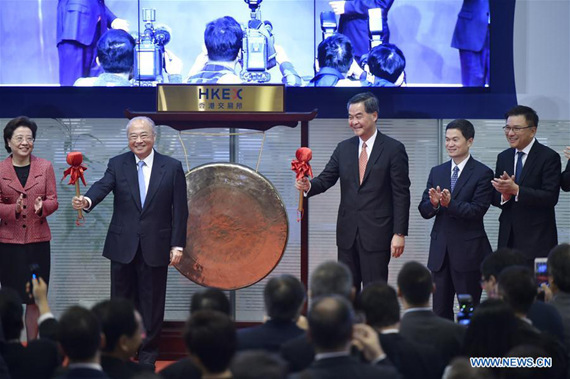Shenzhen-Hong Kong Stock Connect officially starts
China’s stock connect between Shenzhen and Hong Kong started Monday, following the successful launch of the Shanghai-Hong Kong stock link in 2014, further opening up the country’s capital market.
Trading began at 9:30 a.m. Monday, when the Shenzhen and Hong Kong bourses opened. Investors can now buy and sell shares on each other’s bourses, improving connectivity between the two capital markets.
The first-link deal, on the Shenzhen exchange, was for 100 shares of TV maker Konka, with a value of 481 yuan (70 U.S. dollars), while the first trade on the Hong Kong bourse involved HSBC Holdings stock, valued at 24,500 Kong Kong dollars.
A total of 417 Hong Kong-listed stocks are eligible for trade, and 881Shenzhen-listed stocks.
Launch events were held Monday in Shenzhen and Hong kong.
Liu Shiyu, chairman of the China Securities Regulatory Commission, hailed the “historic moment of the coordinated development of the two capital markets”, saying the launch will inject positive energy and confidence into domestic and international financing markets.
The Shanghai-Hong Kong and Shenzhen-Hong Kong stock links will benefit the economic development of the mainland, Hong Kong and the world, said Liu at the ceremony in Shenzhen. He pledged to crack down on irregularities to protect the interests of investors.
With the launch of the Shenzhen-Hong Kong Stock Connect, the asset allocation choices of investors will be more diversified as overseas investors can buy stocks in the tech-heavy Shenzhen market and the inland capital can purchase Hong Kong stocks, said Xie Yaxuan, a senior economist with China Merchants Securities.
The different investment preferences and cultures between Hong Kong and Shenzhen will also have a deep impact on corporate governance of listed firms, he said.
The Shenzhen Stock Exchange has more than 1,800 listed firms, 70 percent of which are in the high-tech sector.
“The Shenzhen-Hong Kong Stock Connect is an important step for the internationalization of our country’s capital market,” said Xu Hongcai, an economist with China Center for International Economic Exchanges.
The two stock links will make China’s capital market more open and healthier, he said.

The entry of inland capital will bring more vitality to the Hong Kong market while Hong Hong investors will also share the dividends from economic transformation, said Xu.
From now on, the price-to-earning (PE) ratios for the board of small- and medium-sized companies are predicted to fall and some bubbles will be squeezed out, he added.
Investors will also gradually conform to international standards and focus more on value investments, said Xu.
As of mid-November, the Shanghai-Hong Kong Stock Connect had posted accumulative turnover of nearly 3.5 trillion yuan.
Wang Jianjun, general manager of the Shenzhen Stock Exchange, said linking the Shanghai and Shenzhen stock exchanges with tha of Hong Kong will enhance the overall competitiveness of China’s capital market.
“Shanghai, Shenzhen and Hong Kong are China’s key capital markets. The integrated development of the three will boost the overall strength of China’s capital market, making it more competitive and attractive internationally,” said Wang.












